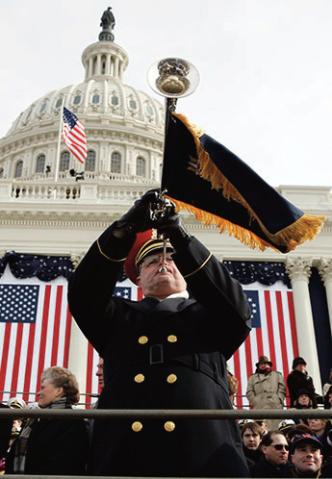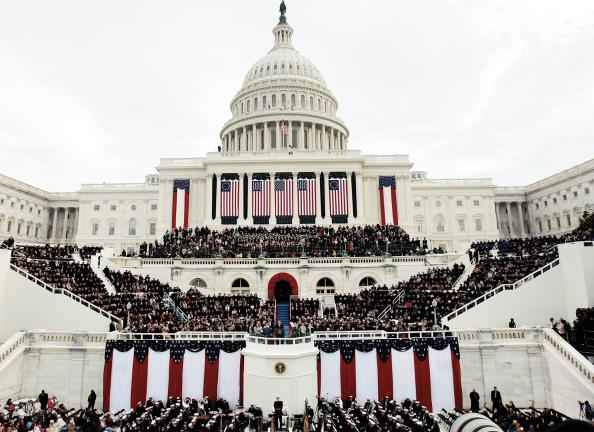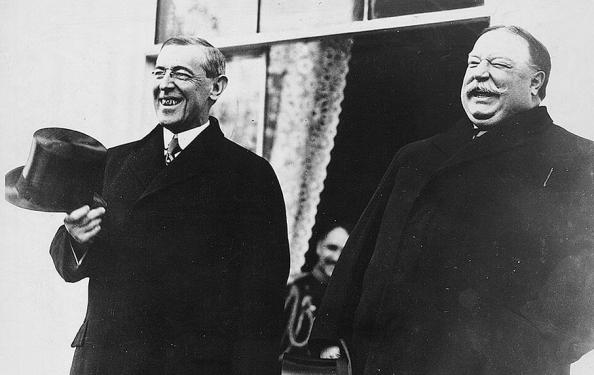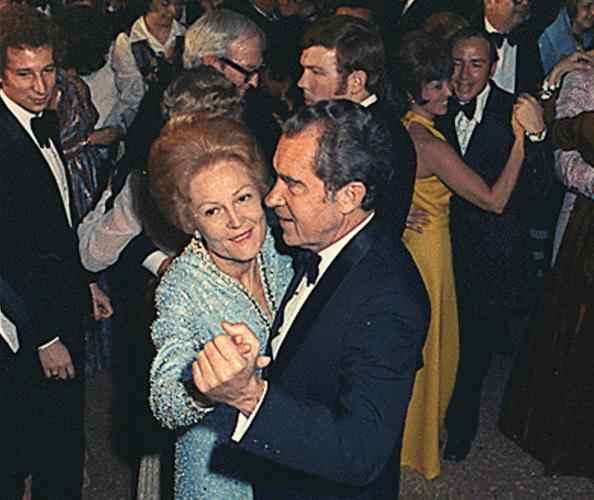Presidential Inaugurations: A Day of Pomp & Tradition

Ruffles & Flourishes Sounded at 2005 Presidential Inauguration (Chuck Kennedy/MCT)
Over the years, Presidential inaugurations have become highly formalized, with the day's scheduled events taking on almost ritualistic significance.
Morning Worship Service
Officially begun in 1933 with Franklin Delano Roosevelt's attendance of a church service at St. John's Episcopal Church (Washington quietly visited a church before his first inauguration), nearly every president since has decided to participate in faith services on the morning of the inauguration.
While most presidents went to Protestant or other Christian churches, John F. Kennedy, the nation's first Roman Catholic president, attended services at Holy Trinity Church.
Procession to the Capitol
Every president has had a form of procession to the swearing-in ceremony, but the procedure we see today was established in 1849 with Zachary Taylor's inauguration ceremony.
After being escorted to the White House by the Joint Congressional Committee on Inaugural Ceremonies commonly referred to as the JCCIC the president-elect, vice-president-elect and their spouses are joined by the outgoing president and vice president to journey to the Capitol for the swearing- in ceremony. Most presidents have ridden to their inaugurations in a carriage or automobile. Thomas Jefferson and Andrew Jackson both walked to their ceremonies.
In 1869, Andrew Johnson became the third outgoing president to not accompany his successor on the procession; Johnson was inside the White House until his term expired at noon, signing last-minute bills into law.
Vice President's Swearing-In Cermony
The Constitution specifically requires the vice president and other elected officials to step forward to take an oath to defend the Constitution, but unlike the presidential oath, it does not specify the form that oath must take. Also unlike the presidential oath, a variety of public officials can and have administered the oath to the incoming vice president. The oath, dictated by Congress, is the same one repeated by senators, representatives and other government officers, and has been in use since 1884. Since 1981, the swearing-in ceremonies have been held at the west front terrace of the Capitol.
President's Swearing-In Ceremony and Inaugural Address
Article II, Section 1 of the U.S. Constitution includes the oath of the office of president. The president is typically sworn in by the chief justice of the Supreme Court in front of the Capitol, though this has frequently changed due to circumstance. The oath reads:
"I do solemnly swear (or affirm) that I will faithfully execute the office of President of the United States, and will to the best of my ability, preserve, protect and defend the Constitution of the United States."
And, of course, the president's swearing-in ceremony is accompanied by the inaugural address, which is often the most anticipated portion of the inauguration.
Though George Washington's first address was lackluster, other addresses have set the tone for the presidency.
William Henry Harrison gave his inaugural address the longest on record in bitterly cold and inclement weather, which was widely speculated to have caused his death a month later.

George W. Bush delivers his 2005 inaugural speech (Win McNamee/Getty Image)
Departure of the Outgoing President
The 1889 “Handbook of Official and Social Etiquette and Public Ceremonies at Washington" described the ceremony this way:
“His departure from the Capital is attended with no ceremony, other than the presence of the members of his late Cabinet and a few officials and personal friends. The President leaves the Capital as soon as practicable after the inauguration of his successor."
But from the start the 1798 inauguration of John Adams, attended by Washington the public has always paid a great deal of attention to the outgoing president. In recent years, newly installed presidents have accompanied their predecessors to a helicopter waiting to see the former president and his spouse off.

President-elect Woodrow Wilson (L) and President William H. Taft (R) share a laugh prior to Wilson's inauguration ceremony in 1913.
Inaugural Luncheon
This tradition started in 1897, when the Senate Committee on Arrangements gave a luncheon for President William McKinley. Other presidents played host in a similar manner in 1945, Roosevelt hosted more than 2,000 guests at the White House. The tradition did not begin in its current official form until 1953, when President Dwight Eisenhower and 50 other guests of the JCCIC ate creamed chicken, baked ham and potato puffs in the Old Senate Chamber. The JCCIC luncheon usually includes speeches, gifts from the JCCIC and toasts to the new administration.
Inaugural Parade
Going back to the first, the parade is an Inauguration Day standby. When the JCCIC has concluded its luncheon, the president and vice president will journey down Pennsylvania Avenue to the White House amid streamers, confetti and general celebration.
While the first parades were informal affairs, James Madison was accompanied by cavalry during his 1809 inauguration, setting the tone for the future. Abraham Lincoln's second inauguration in 1865 148 years before this year's swearing-in of Barack Obama was the first time blacks were allowed to march in the parade.

Inaugural Parade Route
Inaugural Ball
Though the practice began informally, with multiple balls following Washington's first inauguration, the growing number of balls necessitated the construction of dedicated ballrooms in Judiciary Square. Eventually, the idea of a single ball that could accommodate thousands of guests was embraced by partygoers who wished to view the newly sworn-in president.
The event was canceled for the first time in 1853, when Franklin Pierce wished to mourn the loss of his son. Sixty years later, Woodrow Wilson firmly canceled the inaugural ball, and the practice of private parties sprang up when Warren G. Harding asked for a simple affair without pageantry to mark the occasion of his inauguration. In 1949, Harry Truman revived the practice of the ball, and Eisenhower's inauguration in 1953 necessitated a second ball due to great demand for tickets. The number of balls reached a high of 14 during the second inauguration of President Bill Clinton in 1997.

President Nixon dances with wife Patricia at an inaugural ball (1973)
WORLD | AFRICA | ASIA | EUROPE | LATIN AMERICA | MIDDLE EAST | UNITED STATES | ECONOMICS | EDUCATION | ENVIRONMENT | FOREIGN POLICY | POLITICS
© Tribune Media Services